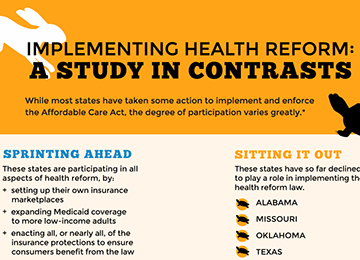The Affordable Care Act has the potential to increase access to coverage for millions of Americans primarily through three mechanisms: 1) the implementation of market reforms; 2) the establishment of new health insurance marketplaces, also known as exchanges; and 3) the expansion of Medicaid eligibility for low-income adults. This report examines the status of state implementation of each of these reforms in all 50 states and the District of Columbia.
Understanding State Implementation of the Affordable Care Act
States varied significantly in their approach to implementing the Affordable Care Act’s three major components, but states were most likely to take new action to implement the market reforms. These reforms include access to coverage for young adults, a ban on preexisting condition exclusions, the coverage of a minimum set of essential health benefits, and a ban on lifetime limits for health care coverage, among other critical consumer protections. To date, 32 states and the District of Columbia have taken new legislative or regulatory action on at least one of the market reforms. Of these, 11 states addressed all of the reforms studied in this report. Although states may not have taken new action to implement each of the reforms, state regulators in the vast majority of states will use their authority or collaborate with federal regulators to require or encourage compliance with the new protections. In the five states that declined to enforce these reforms, federal regulators will do so to ensure that consumers receive the benefits promised under the Affordable Care Act. Seven states—Connecticut, Hawaii, Maryland, Massachusetts, Minnesota, Oregon, and Vermont—fully embraced all three major components by implementing the market reforms, establishing a state-based marketplace, and expanding their Medicaid program. Other states that have actively implemented the Affordable Care Act—such as California, Colorado, and New York—nearly met this standard. At the other end of the spectrum, five states—Alabama, Missouri, Oklahoma, Texas, and Wyoming—fully declined to play a role in implementing these components.

In the middle of this spectrum, states with state-based marketplaces were more likely to take action on the market reforms and expand their Medicaid programs. But states with federally facilitated marketplaces were also active. Of the 34 states with federally facilitated marketplaces, 18 states took legislative or regulatory action on the market reforms. Eleven states are expanding their Medicaid programs, with an additional four still considering expansion. This variation suggests that states have flexibility in implementing the Affordable Care Act—and are taking advantage of it.
Understanding Market Dynamics
States also amended insurance laws in response to emerging market dynamics. For example, states actively repealed pre-Affordable Care Act protections, enhanced or diminished their authority to review rates, or adopted new requirements for certain products while exempting others from state insurance law. These changes, coupled with the Affordable Care Act’s reforms, represent a significant shift for many states, and the effect of these changes remains unclear. Additional analysis will be critical to understand whether such actions promote or undermine the Affordable Care Act’s reforms and affect the stability of state insurance markets.
Looking Forward
Most states have been active in preparing for the significant changes mandated by the Affordable Care Act. More than half took action to implement or enforce at least one market reform, and state regulators in 32 states and the District of Columbia chose to operate their own exchanges or are playing an active regulatory role by conducting plan management.
Where states have been unable or unwilling to implement the Affordable Care Act, federal regulators have stepped in to directly enforce the market reforms and operate the marketplaces. As a result, nearly all states are requiring or encouraging compliance with the market reforms, every state has a marketplace, and more than half of states expanded their Medicaid programs.
View a more detailed description of state implementation of each of the reforms.
